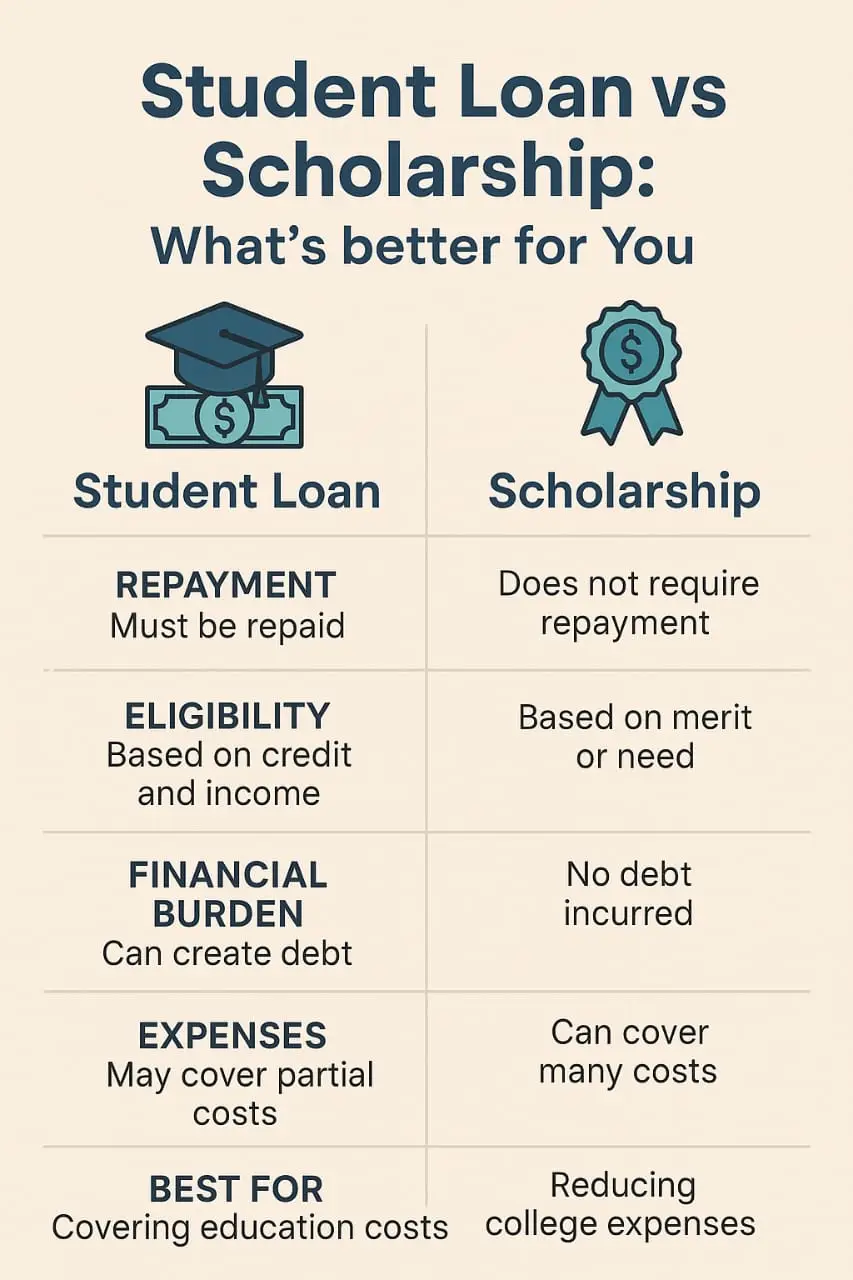Student Loans vs Scholarships: What is Better for You
Higher education is a dream for many students, but the rising cost of tuition, books, living expenses, and travel can turn this dream into a financial burden. To help with the cost, two major options come to mind—student loans and scholarships. But which one is better for you?
In this blog post, we’ll break it down in simple language: what student loans are, what scholarships are, their pros and cons, and real-life examples to help you make the right decision.
How Indian Students Can Afford Higher Education Without Stress
What Is a Student Loan?
A student loan is money you borrow to pay for your education. This money must be paid back later with interest.
For example:
Rahul wants to study engineering at a private college in India. The annual fee is ₹2.5 lakhs. His parents cannot afford it.
So, he takes a student loan of ₹10 lakhs from a bank. After finishing his 4-year course, Rahul will have to repay this loan with interest — maybe ₹12 lakhs or more in total over the next 10 years.
Types of Student Loans
Government Student Loans:
These are provided by national banks or government bodies like SBI, Canara Bank, or the Indian government’s Vidya Lakshmi Portal.Private Loans:
Taken from private banks or financial institutions like HDFC Credila or Axis Bank.International Loans:
For students going abroad, there are loans from institutions like Prodigy Finance, MPOWER, or banks like ICICI or SBI Global Ed-Vantage Loan.
What Is a Scholarship?
A scholarship is free money awarded to a student based on merit (like marks), need, sports talent, or special categories. You do not need to repay a scholarship.
For example:
Priya scores 95% in her Class 12 CBSE board exams. She applies for the INSPIRE Scholarship by the Indian government and gets ₹80,000 per year to support her science degree. She doesn’t have to repay it.
Types of Scholarships
Merit-Based Scholarships:
Given for high academic performance.
Example: KVPY (Kishore Vaigyanik Protsahan Yojana)Need-Based Scholarships:
For students from economically weaker sections.
Example: NSP (National Scholarship Portal) for SC/ST/OBC students.Talent-Based Scholarships:
For sports, music, or art skills.
Example: Sports quota scholarships in universities.International Scholarships:
Many universities abroad offer full or partial funding.
Example: Chevening Scholarship (UK), Fulbright (USA), DAAD (Germany).
Is Social Media Helpful or Harmful for Students
Student Loans vs Scholarships: What is Better for You?
Student Loan vs Scholarship: Key Differences
| Factor | Student Loan | Scholarship |
|---|---|---|
| Repayment | Must be repaid with interest | No repayment needed |
| Based on | Anyone can apply | Based on merit, need, or talent |
| Availability | Easier to get from banks | Competitive and limited seats |
| Time to Apply | Anytime during admission | Usually specific deadlines |
| Financial Burden | Creates a future repayment burden | Reduces or removes financial burden |
| Impact on Career | Pressure to earn quickly | More freedom to choose career path |
Pros and Cons of Student Loans
✅ Pros
Easy to Get: Most students are eligible if they have admission.
No Need for Immediate Payment: You pay after completing your studies.
Builds Credit History: Helps in getting future loans (home/car) if repaid well.
Covers Full Cost: Tuition + living + books + travel.
❌ Cons
Repayment Burden: EMI payments can be heavy.
Interest Rates: Can increase total cost by lakhs.
Long-Term Stress: Especially if job offers are delayed.
Can Affect Career Choices: You may skip higher studies or low-paying social jobs due to repayment needs.
Pros and Cons of Scholarships
✅ Pros
Free Money: No need to pay back.
Recognition: Boosts confidence and CV.
Less Financial Pressure: You can focus on studies.
Motivates Students: Merit-based scholarships push you to do better.
❌ Cons
Very Competitive: Hard to get.
Limited Seats: Many deserving students miss out.
Not Always Full Support: Some scholarships only cover tuition, not living expenses.
Eligibility Rules: Some are only for certain categories or states.
Top 20 Free Online Courses App in India
Real-Life Examples
Example 1: Neha’s Story – Scholarship Success
Neha, from a small village in Bihar, scored 98% in her board exams and cleared NTSE. She applied for multiple scholarships and got ₹1 lakh per year through the Maulana Azad Scholarship for girls. She completed her B.Sc. without her family spending a rupee.
Example 2: Amit’s Loan Journey
Amit, from Delhi, wanted to do an MBA in the USA. His course cost ₹40 lakhs. He got admission but no scholarship. He took a loan from SBI Global. After graduation, he got a job in the US and started repaying. It took him 7 years to clear the loan.
Tips for Students and Parents
1. Always Check for Scholarships First
Before applying for a loan, search for scholarships you may be eligible for — local, national, or international.
2. Plan Early
Most scholarship deadlines are before or just after admission. Keep documents ready: mark sheets, income certificate, caste certificate, etc.
3. Talk to Your College
Many colleges have internal scholarships, fee waivers, or tie-ups with banks.
4. Mix Both If Needed
Some students use partial scholarships and take small loans to cover the rest.
Websites to Explore
Which Is Better—Student Loan or Scholarship?
There is no one-size-fits-all answer. Here’s a simple guide:
If you have strong marks or talent, apply for scholarships first.
If you don’t qualify for scholarships but still want to study, go for a student loan — but borrow wisely.
If your goal is studying abroad, try for international scholarships like DAAD (Germany) or Erasmus (Europe).
If you’re from a low-income family, look for government support like NSP, PMSSS (Jammu & Kashmir), or state-level scholarships.
Final Thoughts on Student Loans vs Scholarships: What is Better for You
Education is an investment. Whether you use a scholarship or a loan, the goal is to build a better future. But it’s important to understand the financial responsibility that comes with each choice.
Scholarships give you freedom; loans give you opportunity.
Choose the one that best suits your situation, dreams, and career plans.
If you’re unsure, speak to your teachers, college counselors, or financial advisors. Start early, plan wisely, and chase your dreams without fear.
If you found this blog helpful, share it with your friends and classmates. For more tips on education, scholarships, and student life, keep visiting knowledgehubforall.com. ✨






